To grow taller or not? Plants “make” different “decisions”
How do plants “see” their neighbors?
In nature, it is very common that a plant perceives somehow reduced light source, while growing underneath the leaf canopy, or shaded by neighbor vegetation. Being shaded plants “see” the altered information signals, mainly reduced light quantity and different light quality, with photoreceptors. The former leads to reduced photosynthetic active radiation (PAR) – the fluence rate of light between 400 and 700nm wavelength which drives the reactions of photosynthesis. Whereas the latter causes a decrease in blue light, as well as the ratio of red to far-red wavelengths (low R:FR). Monitoring of the change of light quality provides shaded plants with an early warning of the presence of competing neighbors.
To avoid, or to tolerate
In a shade avoiding plant (e.g. Arabidopsis.thaliana, Sinapis alba), escape responses such as rapid elongation of stems and leaves as well as upward reorientation of leaves are observed. Shade-tolerant plants, on the other hand, exhibit reduced or even absent shade-avoidance traits. This is mostly seen in perennial tree species, which cannot escape shade environments when growing in forest under-stories.
However, one cannot simply assume that shade tolerance is only a lack of the shade-avoidance syndrome (SAS), a complex and specific adaptation, such as increased spe-cific leaf area (SLA) to greatly enhance carbon gain, and higher level of plant defense (biotic or abiotic stress) were hypothesized. Until now, the efforts were mostly made to focus on the ecological and ecophysiological level. Shade-tolerant model species to un-ravel the molecular regulation of shade tolerance, however, are yet lacking.
The difference of responses in different species to shade made us curious to test the proposed model perennial species Arabis alpina, which is a close relative of A.thaliana. We observed shade tolerance in the wild type Pajares at seedling stage, but reversed shade response in one of the accessions – similar to a Phytochrome B (which belongs to the Phytochrome family of photoreceptors) mutant observed in Arabidopsis. The different phenotypes we observed in A. alpina might be because A. alpina evolved to adapt themselves to conditions of stronger incident radiation. Within CEPLAS, one of our efforts is to identify the possibly diverged function of known shade-related genes in A.alpina, which might contribute to the interesting phenotypes we observed.
Why is NOT growing tall important?
In agriculture, shade avoidance response is an unfavorable characteristic in most crop plants, due to the fact that carbon is being allocated to stem elongation, rather than leaf and root development which contribute to higher yield. Therefore, understanding the molecular mechanisms of shade-tolerant plants will not only help us get a clear view of the signaling pathway related to shade, but is also agronomically important.
Contribution by Panpan Jiang, Cologne Biocenter
Planter’s Punch
Under the heading Planter’s Punch we present each month one special aspect of the CEPLAS research programme. All contributions are prepared by our young researchers.
Corresponding publications
Franklin KA (2008) Shade avoidance. The New phytologist 179(4):930-944. [Abstract]
Valladares F, Niinemets U (2008) Shade Tolerance, a Key Plant Feature of Complex Nature and Consequences. Annual Review of Ecology Evolution and Systematics, Annual Review of Ecology Evolution and Systematics, (Annual Reviews, Palo Alto), Vol 39, pp 237-257. [Abstract]
